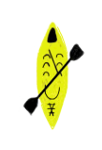
Boat construction is considered by many to be the ultimate test of carpentry skills. Also a test of patience as many hours of work sometimes spanning years are required to construct a seaworthy craft.

Boat construction is considered by many to be the ultimate test of carpentry skills. Also a test of patience as many hours of work sometimes spanning years are required to construct a seaworthy craft.
The first kayak chosen by our boat builder here at Arenal Boatworks was of course the Great Auk taken from the book by Nick Schade, The Strip-Built Sea Kayak. With no previous experience with a sea kayak I was very curious to find out how a kayak of this type would handle in the lake. Up to this point, my kayaking experience (okay, that's stretching it a bit) has been 99% on the sit-on-top boats that we have for our rentals. A couple of times I had opportunity to try a friend's kayaks that were closer to the Great Auk design but they were too small for me and uncomfortable making the experience less than enjoyable. Now that I've had a couple of months in the Great Auk, I can speak with at least some experience about sea kayaks in general and this one in particular.
For many years the sea kayak has been a mysterious thing. Isn't it scary being inside a 17' or more boat that fits like a sock over the lower body? And what happens when one tips over? Are you trapped inside? How in the world did the northern people navigate freezing water in one of these things? And hunt game at the same time? Well, even though I was going to go ahead and build one based on a traditional kayak, these kinds of questions were still working on my brain.
Talking with a friend and neighbor here on the lake helped. He said that in all his years of kayaking he's never rolled one. At least not intentionally. So that meant the boat must be fairly stable. All I had for experience was a lot of canoeing on rivers and lakes and even though pretty confident in a tippy canoe, the skinny kayak seemed like it couldn't wait to roll over.
Now I can say that a sea kayak is very stable on the water. The Great Auk is anyways. Sure it'll tip when you want and sometimes when you don't. Had a couple of wet exits to demonstrate what a high center of gravity will do. Sitting on the rear deck is a very unstable position and tipping over is easier than breathing. But, I've yet to tip while underway and paying attention which indicates good primary stability to use some kayak terminology. There is also a parameter called secondary stability which refers to the ability to hold a leaning position when turning the boat or when weather cocked.
So, let's talk about turning the Great Auk. Keep in mind that this kayak is 5 meters long (17'-6"). To turn a kayak while underway it is necessary to lean opposite the turn in order to use the hull's curvature to make the boat turn. This is without a rudder of course. The Great Auk responds well to a lean only turn keeping paddle strokes even on both sides. I don't have a number to describe the turn radius but given it's 5m length, the radius is large.
There are many ways to reduce the radius, using the paddle as a rudder, installing a rudder and using it, short stroking on the inside of the turn, and many other ways to alter the paddle stroke and position to effect a quicker turn. The Great Auk responds well to any of these techniques (except I don't have a rudder). Other conditions, wind and current in particular, impact effective turning ability and require some creative paddling to overcome. Paddling techniques are not in the scope of this review and if I can find them I'll link to some places on the web that discuss this in great detail.
Slow speed maneuvering is a different story. Moving up from the 3.5m (11'-6") sit-on-top kayak to a 5m boat is quite a big step. Especially since we enjoy paddling back into river mouths looking for wildlife. Turning a 5m boat in a 2m creek isn't going to happen. Means backing up a lot. But, with enough space, the boat is easy enough to turn around in its own length by pushing and pulling from opposite sides.
Paddling in any wind or current has been difficult. Normal tracking of the boat is okay, not great, requires paying attention to keep a straight line and when not paddling the boat tends to head upwind or into the current. As near as I can tell this means that the after portion of the hull is being affected by the wind and/or current. To reinforce this analysis I can reduce the tendency if I lean way back moving the effective CG aft and placing more of the after hull in the water. A lighter paddler would probably experience even more difficulty and that's been shown to be true. Is this a flaw in the design? Something that happened as a result of the lofting of offsets and construction? I have no way to tell without some sophisticated testing equipment so a seat of the pants review is going to suffice. Thinking about experimenting with a skeg to see if tracking can be improved some.
Bottom line? This is a great boat! Fun to build and a joy to paddle. Someday, if I develop enough skill, maybe it'll seem too tame a craft but as a first kayak to build and own I highly recommend the Great Auk and Nick Schade's book on building.
